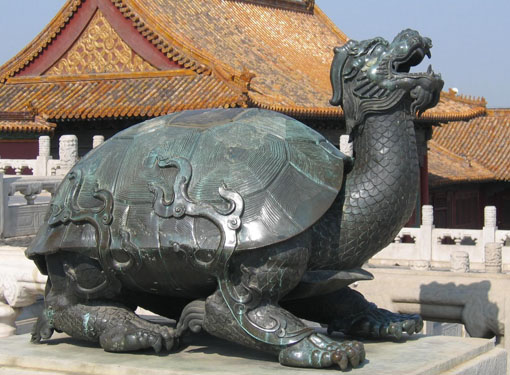Artist:
unkown artist
Title:
Turtle Statue
Year:
1420
Adress:
Forbidden City
www.chinaexposure.blogspot.nl:
The Forbidden City, which was a home to 24 emperors of the Ming and Qing Dynasties, is the best-preserved imperial palace in China and the largest palatial formation in the world. The Forbidden City, situated in the hart of Beijing, consists of 90 palaces and courtyards. There are 980 buildings and 8,704 rooms and few gardens. In ancient Chinese times, the emperor proclaimed himself as the son of Heaven. The emperors’ palace was built as a replica of the Purple Palace, a God residence in Heaven. The emperor palace was perceived as a divine place and was forbidden to ordinary citizens, visitors, therefore it received the name Forbidden City. The Hall of Supreme harmony in Forbidden City is guarded by this bronze statue of turtle. Despite its fearsome appearance, the turtle was viewed in China as a symbol of peace.
www.wikipedia.org:
The Forbidden City was the Chinese imperial palace from the Ming dynasty to the end of the Qing dynasty. It is located in the center ofBeijing, China, and now houses the Palace Museum. It served as the home of emperors and their households as well as the ceremonial and political center of Chinese government for almost 500 years. Built in 1406 to 1420, the complex consists of 980 buildings and covers 72 ha (180 acres). The palace complex exemplifies traditional Chinese palatial architecture, and has influenced cultural and architectural developments in East Asia and elsewhere. The Forbidden City was declared a World Heritage Site in 1987, and is listed by UNESCO as the largest collection of preserved ancient wooden structures in the world. Since 1925, the Forbidden City has been under the charge of the Palace Museum, whose extensive collection of artwork and artifacts were built upon the imperial collections of the Ming and Qing dynasties. Part of the museum's former collection is now located in the National Palace Museum in Taipei. Both museums descend from the same institution, but were split after the Chinese Civil War.
The Forbidden City, which was a home to 24 emperors of the Ming and Qing Dynasties, is the best-preserved imperial palace in China and the largest palatial formation in the world. The Forbidden City, situated in the hart of Beijing, consists of 90 palaces and courtyards. There are 980 buildings and 8,704 rooms and few gardens. In ancient Chinese times, the emperor proclaimed himself as the son of Heaven. The emperors’ palace was built as a replica of the Purple Palace, a God residence in Heaven. The emperor palace was perceived as a divine place and was forbidden to ordinary citizens, visitors, therefore it received the name Forbidden City. The Hall of Supreme harmony in Forbidden City is guarded by this bronze statue of turtle. Despite its fearsome appearance, the turtle was viewed in China as a symbol of peace.
www.wikipedia.org:
The Forbidden City was the Chinese imperial palace from the Ming dynasty to the end of the Qing dynasty. It is located in the center ofBeijing, China, and now houses the Palace Museum. It served as the home of emperors and their households as well as the ceremonial and political center of Chinese government for almost 500 years. Built in 1406 to 1420, the complex consists of 980 buildings and covers 72 ha (180 acres). The palace complex exemplifies traditional Chinese palatial architecture, and has influenced cultural and architectural developments in East Asia and elsewhere. The Forbidden City was declared a World Heritage Site in 1987, and is listed by UNESCO as the largest collection of preserved ancient wooden structures in the world. Since 1925, the Forbidden City has been under the charge of the Palace Museum, whose extensive collection of artwork and artifacts were built upon the imperial collections of the Ming and Qing dynasties. Part of the museum's former collection is now located in the National Palace Museum in Taipei. Both museums descend from the same institution, but were split after the Chinese Civil War.



